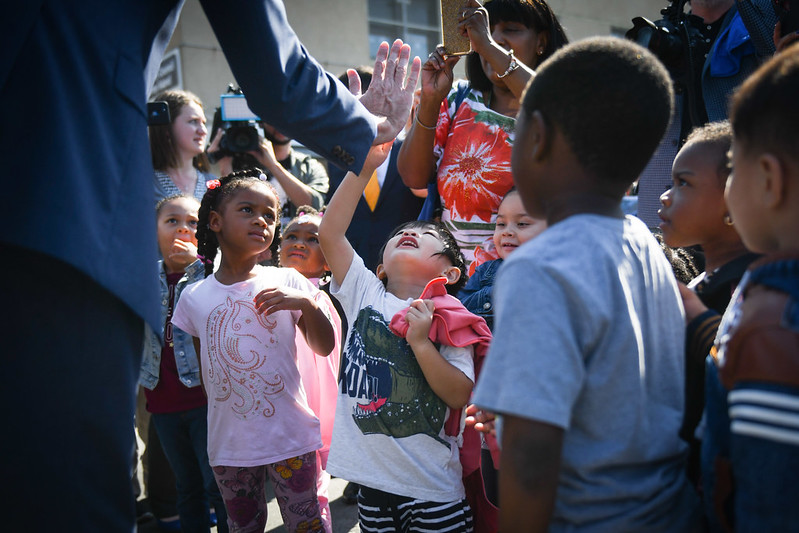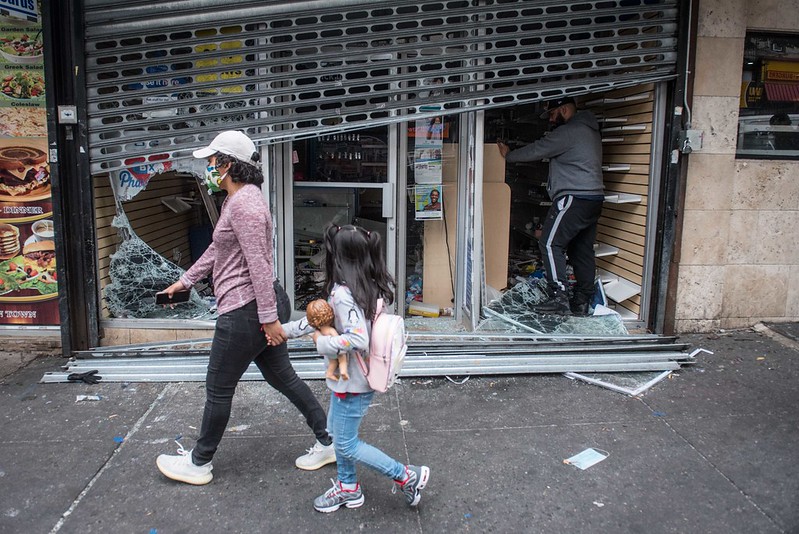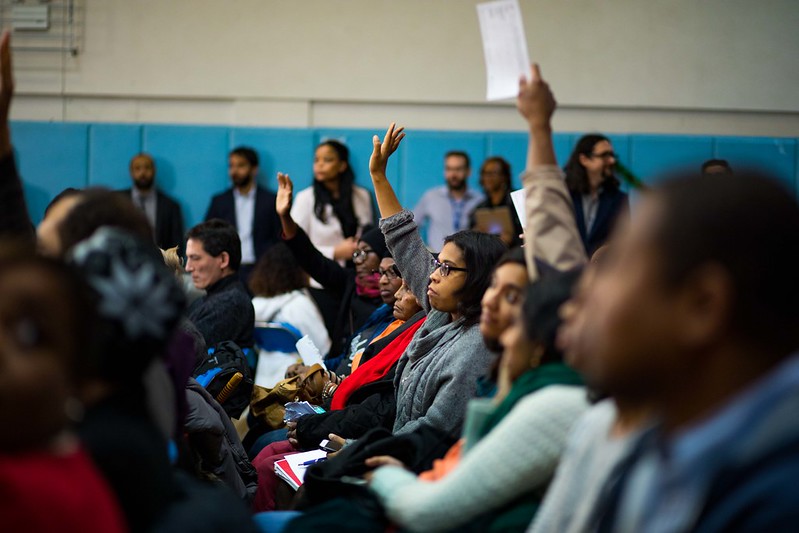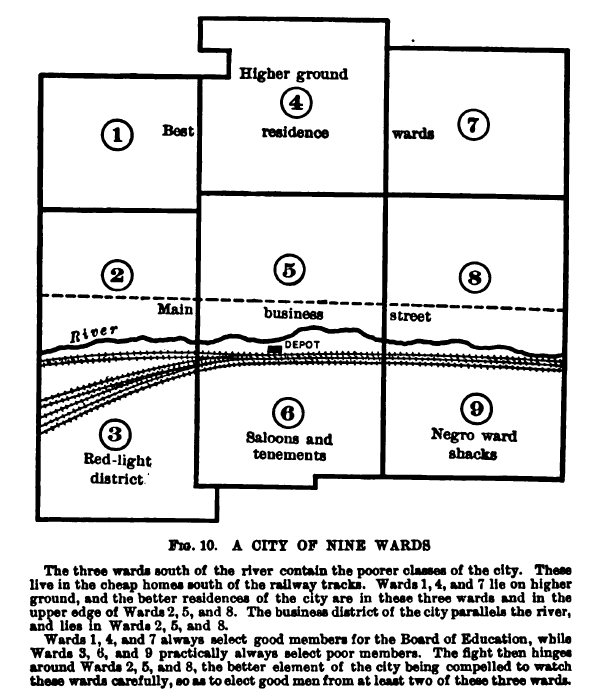Giving New York City’s 114,000 Homeless Children a Better Shot in School

New York City school children (photo: Michael Appleton/Mayor's Office)
As thousands of demonstrators march through the streets of New York City calling for an end to police brutality and equality of opportunity for people of color, and we are on the verge of sending our children back to school of some kind, it is time that we focus on the most vulnerable people of color, and that is homeless children.
The organization Advocates For Children estimates that there are 114,000 homeless students in the New York City school system and that 85% are Black or Hispanic. This figure includes children not only living in shelters but also those that live doubled up with family or friends. These students perform significantly lower on state tests and only 57% graduate from high school, compared to 76% of all city students who are not homeless.
If we are going to make a difference in the way people of color are treated and accomplish economic security, it is essential that major efforts be put forward to lift these currently homeless children, improve their stations, and greatly increase their rate of high school graduation.
In the homeless shelter system we have approximately 11,000 families with children. On a relatively positive note this figure is down by 1,000 from the same time last year but still very high. However, we still have 20,000 children living in the shelter system. It is time we make a critical element of the evaluation of the work of the New York City Department of Homeless Services that children in their shelters and hotels show improved performance in school.
In order to understand the larger circumstances that these children and their parents live in, we must look at their environment. Typically a homeless family lives in a shelter unit or hotel room that is the equivalent of a small studio apartment. There are bunk beds for the kid(s) and a bed for the parent(s). Of homeless families, 80% are headed by a single adult female. There is a small kitchen area and a table and chairs to eat on and a bathroom. However, those families residing in hotels, at a cost of roughly $200 a night, often do not have a kitchen and depend on food deliveries three times a day.
Obviously, you can see the challenges of trying to do your schoolwork in such an environment. As a former Deputy Commissioner at the Department of Homeless Services and a senior executive at nonprofits that provide shelter and supportive housing for families, I know these circumstances all too well. It’s time that every shelter and hotel that houses homeless families be required to provide space for children to do their schoolwork. This could be accomplished in some cases, perhaps, by designating one study room for every four residential rooms.
Additionally, all homeless students should receive tutoring from a new program I am calling CUNY Students Supporting Homeless Children.
As a graduate of Brooklyn College and a New Yorker, I know that CUNY students could be extremely helpful to some of our most vulnerable students, and they could also earn some extra much-needed money. Children residing in the shelters, and those living doubled up, should also be given a laptop computer and provided with access to the internet so that they can access a wealth of important resources and also receive tutoring via Zoom as needed.
The nonprofit providers who run the shelters and the hotels would be given performance standards to ensure that their students are doing better in school and more are graduating high school. Failure to meet these standards could result in a cut to their contracts.
You may be thinking that this sounds great, but with looming budget cuts how are we going to pay for this program? We should create a public-private partnership with some of the more famous billionaires and philanthropists who live and work within our midst, like Jeff Bezos, Bill Gates, and former Mayor Michael Bloomberg who is well known for his interest in education and supporting important philanthropic causes. The goal should be to raise $1 billion to fund this campaign, including reaching out to the general public, members of which often care about our most vulnerable children but don’t always know how to help them. New Yorkers could get involved through a Go Fund Me-type page. It must be understood and guaranteed by New York City government that the monies raised through this initiative cannot be diverted to other programs.
Over 100,000 homeless children are now drowning, with far too many destined to fail given current conditions. While we also work to get them all safely housed, this initiative could provide them with a lifeboat to allow them to overcome their severe challenges, improve at and enjoy school, graduate, and have more opportunity.
***
Robert Mascali is former Deputy Commissioner to the New York City Department of Homeless Services and Vice President for Supportive Housing for Women in Need.
***
Have an op-ed idea or submission for Gotham Gazette? Email This email address is being protected from spambots. You need JavaScript enabled to view it.
Don’t Throw Out New York with the Police Reform

Aftermath of looting in the Bronx (photo: Michael Appleton/Mayor's Office)
Growing up near New York City in the 1970s and ‘80s, the city seemed a terrifying place, full of gangs, muggers, and tabloid-worthy murders.
By the time I moved to the city for work in the mid-’90s, however, it was in the midst of a transformation. The first two neighborhoods I lived in, in Manhattan, were Murray Hill and the East Village, and both initially had terrible reputations. Murray Hill featured street prostitutes and notorious single resident occupancy hotels, and the East Village was infamous for its “needle park” in Tompkins Square.
But the SROs became boutique hotels and the prostitutes became European tourists asking for directions. Tompkins Square Park evolved into a place for concerts and young families (mixed in with some needle users). The changes were emblematic of neighborhoods all over the five boroughs.
Why? It started with order and safety. Crime famously plummeted in New York through the 1990s and people living a more ordered life centered around work and the city’s cultural and nightlife followed. And the rebirth of New York as the nation’s economic and cultural capital has continued into the new century and over the last two decades.
But that incredible transformation is threatened today. Not just because of COVID-19, but also because of an overdue reform movement that is protesting publicly for a new paradigm in the relationship between public safety and order and the rights of people of color.
It is a movement full of the passion and talent found so often in New York’s young people. But those strengths are also a risk, of going too far and destroying the very place that helps bring that passion and talent to life.
It's time for the protesting to stop and the harder work of building the city back to begin.
I’m not some “law and order” ideologue who wants to see “rioters” put in their place. I’ve spent much of my professional career working in New York City during its transformation, for Democratic elected officials and candidates, and progressive policy issues.
But for New York to come back after COVID-19, white collar workers from the suburbs will have to return, residents will need to keep pushing the limits of livable neighborhoods, families will have to want to stay, and tourists will need confidence New York City remains vibrant and available.
None of this can happen without a city that feels safe and orderly. That doesn't just mean keeping crime low. It means not having graffiti-covered buildings and subways, protesters destroying property in very public ways, or nightly violent confrontations with police. And it means incorporating the movement’s reforms and leaders into the healthy civic infrastructure that exists in New York.
New York City has always been a place driven by young energy. The constant influx of bright, ambitious, and creative young people is the burning heart of “the city that never sleeps.” Ultimately the success or failure of New York City's future will come down to them.
This generation of young New Yorkers will have to decide what they want. Do they put their incredible drive behind a city that continues to thrive and grow, while it also confronts the need for public safety and public policy reform?
If so, this generation of young New Yorkers needs to work with elected officials, and the civic, business, and labor groups that have stayed committed to New York through thick and thin. And yes, they even have to partner with the police department itself to figure out how it can do the job of ensuring a safe city without unfair and unlawful targeting of people of color.
If not, it means expending that amazing energy on protesting alone. And that would be quite a waste.
***
Stephen Sigmund was Communications and Policy Director for the New York City Council and Chief of Public and Government Affairs for the Port Authority of NY/NJ. He is currently a public affairs consultant working on the Gateway rail program. On Twitter @ssiggy1.
***
Have an op-ed idea or submission for Gotham Gazette? Email This email address is being protected from spambots. You need JavaScript enabled to view it.
Ruling Paves Way for Massive Voting Rights Change to School Board Elections Across New York

School Board elections may soon change across NY (photo: Benjamin Kanter/Mayoral Photo Office)
On May 25 in White Plains, U.S. District Court Judge Cathy Seibel ruled that the at-large system used for electing the nine members of the East Ramapo School Board denied the district’s Black and Latino voters effective choice in its elections, violating §2 of the Federal Voting Rights Act (VRA). Under an at-large system every voter votes to fill each board position, allowing a disciplined majority to control all seats. A majority of the East Ramapo district’s voting population is Hasidic Jews. The School Board has long been dominated by members recruited and endorsed by the leaders of this religious community and elected at-large through the use of block voting.
Children of Hasidic families in the district all attend private religious schools (Yeshivas) to which the board regularly diverts resources. Meanwhile the board’s tax cutting and repeated austerity budgets have starved the district’s public schools, where most of the students are members of minority groups. To redress this bias, Judge Seibel barred further at-large elections for the nine-member school board and ordered the immediate development of a ward-based plan for conducting future school elections. Under a ward system, board members are elected from geographically defined districts, permitting the election of members supported locally but not favored by the jurisdiction-wide majority.
The decision in this case, National Association for the Advancement of Colored People, Spring Valley Branch et. al. v. East Ramapo School District (17-CV-8943 (CS)), is historic for two reasons:
1. For the first time since the passage of the Voting Rights Act over a half-century ago, it has been used to require structuring choice in New York’s school board elections in a way known to be more responsive to minority communities. East Ramapo will become only the second of New York State’s 688 school districts to have ward-based elections. (The other is the City of Buffalo.)
2. Voting Rights Act litigation has previously been used to halt the use of at-large elections in New York municipalities, but until now the necessary evidence could not be marshalled to successfully challenge the practice in school districts. Judge Seibel relied heavily on expert political science testimony employing the statistical techniques of Ecological Inference and Bayesian Improved Surname Geocoding (BISG).
She wrote: “This may be the first time that voter-preference estimates based on BISG have been admitted into evidence at a VRA trial.” If sustained on appeal, this decision will provide the basis for change elsewhere, facilitating elections of members preferred by minority-community voters.
At-Large and Ward-Based Elections
New York law provides that all village, town, and school board elections be conducted at-large. As an alternative, towns and villages may adopt the use of wards by referendum. However, school districts may not.
The early 20th century progressive reformers who designed New York’s school governance system sought to “separate education from politics.” For them ward-based urban political machines were anathema. They wanted governance in the hands of “better men.” At-large elections were their primary tool for achieving this end.
These reformers were not shy about their unabashedly social and racial bias, as illustrated in the map and accompanying text below, taken from a 1916 book written by Dean and Professor Elwood Cubberly, cited by the New York State School Board Association as a framer of the New York system. Their preferred at-large system was discriminatory not only in its effect, but in its intent.

Evidence and Statistics
The discriminatory effect of at-large election was well-known by the time the Voting Rights Act was passed in 1965. The challenge was to prove it denied protected minorities effective choice in elections in specific cases to the satisfaction of federal judges. The courts required that members of these minorities seeking redress under the VRA show that the manner in which their jurisdiction’s election was structured systematically precluded them from having any impact on outcomes.
Voting is confidential. So is Census information. We do not keep individual level records about a person’s voting behavior or residence by race. Until now, therefore, proof of the invidious effect on minorities of the manner in which electoral choice is structured was built from a combination of place-specific voting records from their neighborhoods – aggregate election outcomes from Census blocks made up largely of minority group residents.
But in New York State, school board elections, unlike those for municipalities, are not conducted in geographically specified election districts. Aggregate place-specific records of voting by members of minority groups are therefore not available to combine with Census information to provide the needed proof of structural bias. Though VRA litigation has been successful in challenging the discriminatory effect of at-large elections for municipal elections in the state, conducted in geographically defined election districts, the impossibility of gathering needed evidence has heretofore blocked mounting similar litigation challenging the at-large structure of school board elections.
To overcome this barrier, lawyers for the NAACP brought in political scientists expert in Ecological Inference and BISG. Ecological Inference, pioneered by Gary King, a graduate of SUNY New Paltz and now a professor at Harvard, permits inferring individual behavior from group-level data. BISG combines individual level information about persons’ names with the place where they live to predict their race and/or ethnicity with high probability.
Much of Judge Seibel’s compelling 77-page opinion is devoted to a careful assessment of political scientists’ expert testimony and an explanation of why she finds it compelling in proving that the at-large system used in East Ramapo is in violation of the Voting Rights Act. As the case goes forward on appeal, however, it is cautionary to recall that the judge is functioning in a system headed by U.S. Supreme Court Chief Justice John Roberts, who in a redistricting case called political science expert testimony “sociological gobbledygook.”
Turnabout
Though they have long had the choice, only 14 of 932 New York State towns and 4 of 534 villages have opted for ward-based elections. But lately there has been a quickening of interest in this option in the Hudson Valley. The town of Blooming Grove switched over in 2016. Other municipalities have the matter under consideration. Special legislation has been introduced in Albany allowing the adoption of ward systems for the Chester Union Free School District, and the Washingtonville and Warwick Valley Central School Districts. General legislation has been entered by Hudson Valley state legislators to allow local choice of ward systems in Orange County and statewide. Ironically, in these jurisdictions, and increasingly in the wider region, the motivation seems not to assure effective choice by minority-group voters, but the protection of the control of schools by current majorities from a minority community growing rapidly in numbers and power – the Hasidic community – not protected under the Voting Rights Act.
***
Gerald Benjamin is Emeritus Founding Director of The Benjamin Center at SUNY New Paltz.
***
Have an op-ed idea or submission for Gotham Gazette? Email This email address is being protected from spambots. You need JavaScript enabled to view it.




